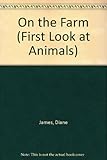Lesson 1: Headings
Lesson Plan
A First Look at Animals: On the Farm

- Learning Goal
- Explain that informational texts include headings that give the topic of a section or chapter.
- Use a heading to make predictions about what a page or section is going to teach you.
- Duration
- Approximately 50 minutes
- Necessary Materials
- Provided: Unit Example Chart, Independent Practice Worksheet
Not Provided: A First Look at Animals: On the Farm by Diane James and Sara Lynn, chart paper, markers, informational books from the classroom or school library
-
Teacher Modeling

will explain that one characteristic of informational books is that they have headings. I will add this to my Characteristics of Informational Books Chart (Example Chart is provided in Unit Teacher and Student Materials). I will explain that headings are titles or names of sections in a book that tell a reader what the section or page is going to be about. Headings can usually be found at the top of a page or section in bold. I will model identifying headings on pages 4 and 6 of A First Look at Animals: On the Farm by Diane James and Sara Lynn. I will read the headings aloud and predict that the sections are going to be about pigs (page 4) and goats (page 6). I will check the section for picture or textual clues to confirm that my prediction is true.
-
Think Check
Ask: "How did I determine or predict what a section or page was going to be about?" Students should explain that you read the heading and used the information in the heading to make a prediction. Then, you checked the picture and text to make sure that you were correct.
-
Guided Practice

will work together to identify the headings on pages 8 and 10 of A First Look at Animals: On the Farm and predict what each section is going to teach us. We will use picture and textual clues to confirm that the title introduces us to that topic. We will reflect that this informational text has headings, so we will add the title to our Characteristics of Informational Books Chart.
-
Independent Practice

will use choose an informational book from your classroom or school library that includes headings for sections or chapters. You will identify the headings and predict what you will learn on that page or section. You will explain how you know your book is an informational book. Your teacher may add the title of your informational book to the Characteristics of Informational Books Chart. (Independent Practice Worksheet is provided.)
Texts & Materials
Standards Alignment
(To see all of the ReadWorks lessons aligned to your standards, click here.)

